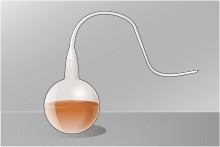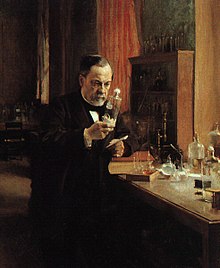Louis Pasteur
About me
|
Born |
December 27, 1822 |
|---|---|
|
Died |
September 28, 1895 (aged 72) |
|
Nationality |
French |
|
Fields |
Chemistry |
|
Institutions |
University of Strasbourg |
|
Alma mater |
École Normale Supérieure |
|
Notable students |
Charles Friedel[1] |
|
Notable awards |
Rumford Medal (1856, 1892) |
|
Signature |
|
Louis Pasteur (/ˈluːi pæˈstɜr/, French: [lwi pastœʁ]; December 27, 1822 – September 28, 1895) was a French chemist andmicrobiologist renowned for his discoveries of the principles of vaccination, microbial fermentation and pasteurization.
Research contributions
Molecular asymmetry

![]()
Pasteur separated the left and rightcrystal shapes from each other to form two piles of crystals: in solution one form rotated light to the left, the other to the right, while an equal mixture of the two forms canceled each other's effect, and does not rotate the polarized light.
In Pasteur's early work as a chemist, he resolved a problem concerning the nature of tartaric acid (1848).A solution of this compound derived from living things (specifically, wine lees) rotated the plane of polarization of light passing through it. The mystery was that tartaric acid derived by chemical synthesis had no such effect, even though its chemical reactions were identical and its elemental composition was the same. This was the first time anyone had demonstrated chiral molecules.
Germ theory of fermentation
Pasteur demonstrated that fermentation is caused by the growth of micro-organisms, and the emergent growth of bacteria in nutrient broths is due not to spontaneous generation, but rather to biogenesis (Omne vivum ex vivo "all life from life").

![]()
Pasteur experimenting in his laboratory.

![]()
Bottle en col de cygne (swan neck duct) used by Pasteur
He exposed boiled broths to air in vessels that contained a filter to prevent all particles from passing through to the growth medium, and even in vessels with no filter at all, with air being admitted via a long tortuous tube that would not allow dust particles to pass. Nothing grew in the broths unless the flasks were broken open, showing that the living organisms that grew in such broths came from outside, as spores on dust, rather than spontaneously generated within the broth. This was one of the last and most important experiments disproving the theory of spontaneous generation.
While Pasteur was not the first to propose the germ theory (Girolamo Fracastoro, Agostino Bassi,Friedrich Henle and others had suggested it earlier), he developed it and conducted experiments that clearly indicated its correctness and managed to convince most of Europe that it was true. Today, he is often regarded as the father of germ theory.
Pasteur's research also showed that the growth of micro-organisms was responsible for spoiling beverages, such as beer, wine and milk. With this established, he invented a process in which liquids such as milk were heated to kill most bacteria and moulds already present within them.Claude Bernard and he completed the first test on April 20, 1862. This process was soon afterwards known as pasteurization.
Beverage contamination led Pasteur to the idea that micro-organisms infecting animals and humans cause disease. He proposed preventing the entry of micro-organisms into the human body, leading Joseph Lister to develop antiseptic methods in surgery.
In 1865, two parasitic diseases called pébrine and flacherie were killing great numbers of silkworms at Alais (now Alès). Pasteur worked several years proving that these diseases were caused by a microbe attacking silkworm eggs, and that eliminating the microbe in silkworm nurseries would eradicate the disease.
Pasteur also discovered anaerobiosis, whereby some micro-organisms can develop and live without air or oxygen, called the Pasteur effect.
Immunology and vaccination
Pasteur's later work on diseases included work on chicken cholera. During this work, a culture of the responsible bacteria had spoiled and failed to induce the disease in some chickens he was infecting with the disease. Upon reusing these healthy chickens, Pasteur discovered he could not infect them, even with fresh bacteria; the weakened bacteria had caused the chickens to become immune to the disease, though they had caused only mild symptoms.
His assistant, Charles Chamberland (of French origin), had been instructed to inoculate the chickens after Pasteur went on holiday. Chamberland failed to do this, but instead went on holiday himself. On his return, the month-old cultures made the chickens unwell, but instead of the infections being fatal, as they usually were, the chickens recovered completely. Chamberland assumed an error had been made, and wanted to discard the apparently faulty culture when Pasteur stopped him. Pasteur guessed the recovered animals now might be immune to the disease, as were the animals at Eure-et-Loir that had recovered from anthrax.
In the 1870s, he applied this immunization method to anthrax, which affected cattle, and aroused interest in combating other diseases.

![]()
Louis Pasteur in his laboratory, painting by A. Edelfeldt in 1885
Pasteur publicly claimed he had made the anthrax vaccine by exposing the bacilli to oxygen. His laboratory notebooks, now in theBibliothèque Nationale in Paris, in fact show that he used the method of rival Jean-Joseph-Henri Toussaint, a Toulouse veterinary surgeon, to create the anthrax vaccine.This method used the oxidizing agent potassium dichromate. Pasteur's oxygen method did eventually produce a vaccine but only after he had been awarded a patent on the production of an anthrax vaccine.
The notion of a weak form of a disease causing immunity to the virulent version was not new; this had been known for a long time forsmallpox. Inoculation with smallpox was known to result in far less scarring, and greatly reduced mortality, in comparison with the naturally acquired disease. Edward Jenner had also discovered vaccination using cowpox to give cross-immunity to smallpox in 1796, and by Pasteur's time this had generally replaced the use of actual smallpox material in inoculation. The difference between smallpox vaccination and anthrax or chicken cholera vaccination was that the weakened form of the latter two disease organisms had been "generated artificially", so a naturally weak form of the disease organism did not need to be found. This discovery revolutionized work in infectious diseases, and Pasteur gave these artificially weakened diseases the generic name of "vaccines", in honour of Jenner's discovery. Pasteur produced the first vaccine for rabies by growing the virus in rabbits, and then weakening it by drying the affected nerve tissue.

